Animal Instinct: Conversation with NFTS Grads Richard Phelan & Francesca Adams
Animal protagonists have been one of the longest running staples of animation, going back to its inception at the turn of the twentieth century. The timeless appeal of anthropomorphism in cartoons has never waned, proving itself adaptable to contemporary storytelling, as evidenced by two of the most recent crop of NFTS short films by young directors Richard Phelan and Francesca Adams. Phelan’s “Damned” is a warmhearted, family-friendly tale of an earnest beaver whose grand ambition – to build the largest dam the forest has ever seen – is enabled when his woodland companions mistakenly believe him to be a messianic leader of sorts. While good intentions reap increasingly disastrous consequences, the overriding message of the film is one of solidarity and persistence.
Adams’s distinctly adult “Bertie Crisp”, by contrast, takes us to a grim coastal world of caravan-dwelling animals, where we meet Bertie, the titular milquetoast at the mercy of his viciously covetous rabbit bride Grace. Unable to conceive, Bertie is instructed to kidnap one of their feline neighbour’s kittens to secretly raise as their own. While poles apart thematically, both films are similarly executed – being predominantly animated in traditional 2D aided by digital processes – and tremendously funny, an increasingly scarce commodity in contemporary student filmmaking. I was fortunate enough to be able to sit down with both directors recently and discuss the parallels and distinctions in making their respective films.

Still from “Damned” (©2011 The National Film and Television School)
Richard: I used to read a lot of comics when I was a kid and watch a lot of films, all sorts of films, live action and animation. I initially trained as a Graphic Designer before moving into animation. I started training in CGI and didn’t take to it at all. I didn’t like the idea of having to build and rig, I just wanted to get straight into the filmmaking. After I graduated I won the School of Animation Storyboard Competition here in Bristol, so I got to study here for a couple of months. It was just an amazing course surrounded by great filmmakers. It made me realise what I wanted to do, and after freelancing on a lot of short films as an animator I then thought it might be interesting to try and tell my own stories. I’d sit in on development meetings and go “Wouldn’t it be cool if this happened?” I figured if I was the director I could say these things with much more authority, so the NFTS was my chance to do that. So yeah, I suppose it’s been a culmination of a love of storytelling. Visually, I loved “2000AD”, “Batman” and everything film, not just the American blockbusters – in Uni I discovered European cinema, Japanese cinema, Ingmar Bergman…my mind is now more open to everything.
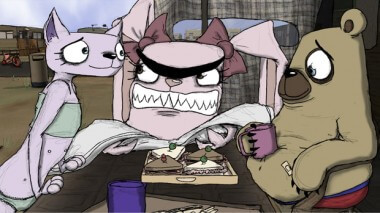
Still from “Bertie Crisp” (©2011 The National Film and Television School)
Francesca: When I was at primary school I wanted to be an animator, it’s always sort of been my thing. I did a BA in animation at Farnham, but I was mostly attracted to film school because with a lot of BAs you find yourself just slung out into the world and left on your own. It had been quite a lonely course because, being a driven animator, I made my film in my house, in my room, on my lightbox, sat on my own. Like Richard said, the main attraction of the NFTS is the idea of collaboration. I wanted to work in a team because I know I’m not strong in every aspect of filmmaking.
Richard: I think you’ve also got to try stuff you don’t like, to know what it is that excites you as a storyteller. I’ve sat through lots of experimental filmmaking and independent films, some of which I hated, but asking myself “Why didn’t I like it? What didn’t work for me?” It kind of strengthens your ideas and the stories you want to tell a bit more.
Which is a valuable thing to be aware of as a filmmaker, knowing what your limitations are but having people you’re connected to that you can rely on.
Richard: We were told at film school, “You don’t have to be the smartest person in the room, you just have to know who that person is”. So to directly say “These are my vague, layman ideas, you’re the professional, you can go do it and I have the confidence in you having talked enough about what the story’s about” you get more and more on the same wavelength everyone knows what the story’s about.
Francesca: Yeah, it’s nice to have all your crew have their bit of input, because then they feel pride in the film as well. It’s great, it pushes them to really feel part of it.
And do you feel that sense of community would perhaps last for future projects and you would work with some of the same people again?
Richard: Oh, definitely. I’d work with all of them again, straight away.
How did you go about developing your initial story ideas into the finished films?
Richard: Well, the original idea came from a piece of classical music which had a nice sort of up-and-down rhythm, and it was about two men trying to build a better house than the other, and it ends with them building these giant houses which both collapse. On the way to the meeting with my co-writer Gareth Sergeant, I suddenly went “All these two lose are their houses, if they were both beavers the damage could potentially kill everyone in the forest, it could go horribly wrong at any time and so there’d be greater tension throughout the story for everyone”. So then the idea became two beavers competing to build the biggest dam, and after more development it went down to just the one beaver. Then there were ideas about what floats down the river to give him the power to control the other animals – for a while it was a piano, at one point there was a dead body that floats down the river, which was very macabre. I didn’t want it to have any limitations when we were in development, once we had the bones we’d roll back and just keep reinforcing the story.
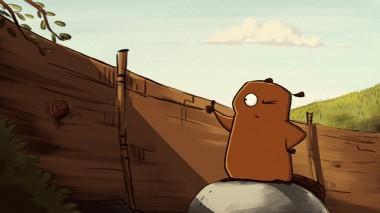
Still from “Damned” (©2011 The National Film and Television School)
Francesca: You guys just mostly laid on the floor.
Richard: Yeah, lying on the floor, going for walks, talking about beavers.
Francesca: Because I love characters, I had started off with mine almost pretty much fully developed, which was quite a different angle to everyone else. I had drawings of Bertie and Grace and this very skinny cat, they all started off looking quite different but I always had this backstory to them. Having developed that first, it was quite nice to be able to almost drop them into a story and see how they’d play, which is where my writer (Laura Poliakoff) really helped. It wasn’t until we’d had this pitch meeting at the NFTS with the heads, where someone suggested thinking of it as a pilot for a series, that everything sort of clicked and we realised it should end on this nice, neat, round note with everything the same as when we begin. That’s when we sort of got rolling, Laura and I wrote a few potential ideas, the two main contenders being where Bertie steals a baby, and another one where Grace finds a bag of drugs and decides she quite fancies being a druggie with Bertie trying to make sure no-one finds out. In the end we realised the baby idea seemed to be the one to run with, but we had fun writing some other potential ones. I’ve got a little press pack with other ideas for episodes, we have the characters already developed and it’s fun to put them in different scenarios. Laura really has a sense of what the characters would do and say, it’s nice to feel that there’s still a lot more to them.

“Bertie Crisp” character designs (©2011 Francesca Adams)
Is there any sense that the characters in “Damned” might similarly have more of a lifespan, for example a follow-up film or series?
Richard: During the writing they did become much more rounded characters, so you could put them in different scenarios. When we were making it our editor, among others, said “There’s a much bigger film here, you could flesh it out and really explore all the different themes and backgrounds and personalities more”. I think that’d be more interesting, to make it in longer form. The beaver is this foiled character, the other animals are quite naïve but they’re content, whereas he has ambitions beyond the world he lives in, so would he always be the one to try and do those things? It’s almost like a short story in that he learns his lesson, then it ties itself up and we’re left with the positive outlook that it won’t happen again. If pushed, I would think about fleshing it out into a longer form, but I never originally imagined it as such.
While being quite distinct stylistically, both your films opt for predominantly traditional animation. Was that your intention from the outset?
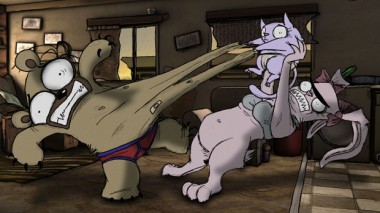
Still from “Bertie Crisp” (©2011 The National Film and Television School)
Francesca: Well, all my films were always completely hand-drawn – pencil, paper, sat at the lightbox – but the thing that annoyed me the most was having to scan in all the frames, you couldn’t get feedback quick enough. I wasn’t that great on a graphics tablet, and in part I had to force myself to become better. Then you realise, yeah, it’s easier to zoom in, to correct things, you’ve got a lot of ease of the digital era but it’s the same sort of feeling after a while. It took me a while to get used to the tablets, because we were on the standard ones where we have to look at the screen and we can’t see our hands. But once I got used to it, now when I go back to my lightbox I have two worn-out areas where I’ll hit where ‘ctrl-z’ would be!
Richard: Originally “Damned” was planned to be 2D characters against CG backgrounds, so I had a very large VFX crew. We had lots of tests of the “Damned” world and its elements, but it just looked like ropey CGI, and I knew that we would never have time to perfect it. I figured if we made it look almost lo-fi then the audience will embrace it more, they’d go “Ah, they’re trying their best”. A lot of the water effects, for example, they’re always done on twos but they flick back so fast and the sound is so immersive that you go “Actually this is quite believable”.
Francesca: I decided to go with the full CG backgrounds, because even though I come a traditional 2D background I do want to try more CG, so I was kind of experimenting with keeping my tradition while taking a step further into the digital world. My CG supervisor Dan, who did all the backgrounds was just brilliant, especially as it’s very hard to get camera moves in a hand-drawn film.
Did you find that using the CG backgrounds would inform other elements of the film, such as laying out the shots or cinematography in general?
Francesca: Yeah, definitely. I mean, it was nice to sit and just play with some of the lighting and bring in a move here and there. If we’d do a shot and realise it needed to be tighter, we could quite easily just go back into the computer, shift the camera a little bit. I learned quite a lot about CG working on it, I think in some areas it works, there’s still a few where unfortunately we struggled to tie up some loose ends but overall it was a fun learning experience.
Going back to your individual visual styles, were there any particular influences you were aware of when developing your characters?
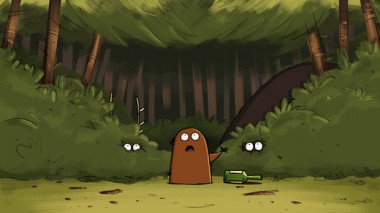
Still from “Damned” (©2011 The National Film and Television School)
Richard: I love Bill Watterson and Quentin Blake, I really enjoy the simplicity of character design, stripping out everything that isn’t necessary so all the characters are quite smooth, apart from the beaver. They’re all quite content while he’s hard-angled, it’s just a simple way of showing that he’s not quite part of their world. So anything superfluous is gone, I tried to make them more fluid so that as shapes they work.
Francesca: I’m almost the opposite, I quite like the lure of details on characters, like Bertie having a little plaster on his belly. I didn’t realise until a tutor pointed out where Grace has a bra on but she doesn’t wear underpants, so I’m like “Oh yeah! There’s probably some camera angles I should stay away from!” It was very strange because at one point Isabella didn’t have anything on top, she’s got eight nipples, but for some reason that looked a bit too rude, and so I put a boob tube over the top two nipples and you can still see all the rest, but it just made the visual more presentable.
There’s a generally dark undercurrent to “Bertie Crisp” that those types of visual ideas were particularly suited to.
Francesca: All my films end up quite dark, and quite silly as well, I don’t necessarily mean to steer them that way but it seems to happen naturally. I absolutely love either things that are completely freakish in mundane situations, or completely mundane in freakish situations, I love that juxtaposition. They’re quite grotesque in some ways but they lead quite boring lives. Although the first script Laura and I wrote got a bit out of hand with the darkness. There was no humour in the actual narrative, whatever there was came from the fact that it’s this funny-looking bear and rabbit, but we’d gone too far down this really dark road and were like “What have we made!?” Luckily we had time to pull back, though unfortunately we had to sacrifice a lot of Bertie’s intelligence to bring it back to this more lighter comedy. He was originally much more deep and complex.
“Damned” seems to have a kind of North American backdrop in terms of the design of the woodlands, was that its intent?
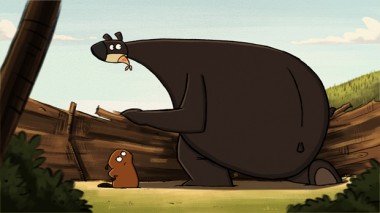
Still from “Damned” (©2011 The National Film and Television School)
Richard:Once I’d decided it’d be about beavers rather than people I researched into it and it just seemed like a North American character, it’s set in a sort of North America that does and doesn’t exist, we’ve got the postcard, the license plate, that kind of generic American imagery. We never actually go into a town, we only see a city in the distance but it’s based on just lots of buildings. I suppose it’s my love of big American films coming through, I can go “Ah, it’s set in America, ooh!” (laughs)
And “Bertie Crisp” has an undeniably British feel, that bleak, cliffside seascape…
Francesca: It’s based on Skegness, where I used to holiday when I was little. I was worried how the situation and the comedy would translate in other countries, because obviously in “Bertie Crisp” they live in a caravan park which over here is related to holidays on the English coast, but a caravan park in America is more associated with trailer trash – but so far it’s not done too bad. It’s screened in a few different countries including the US and so far seems to have gone down quite well.
Both films have quite specific strengths, I think with “Damned” what really cements it as a solid film is the timing, especially when you’re not dealing with dialogue. It’s something that’s very hard to pull off and seen quite rarely in the independent film world and student film world. Was that finessed during the editing after the animation was finished, or was it all timed out at the animatic stage?
Richard: My editor Simon Bullen, who also comes from an animation background, put the animatic together with me. With an animatic being a really stripped-down version it has to work with just a few storyboard panels, so if it didn’t make us laugh at that stage then there’d only be so much the actual animation would add. We’d sit there at the table watching it and shout out “cut” where the timing worked, then test it with people and sit there making notes – “no laughs”, “big laugh, don’t know why”. With each new cut we’d get some fresh people in and note when people would laugh at the same points. Some things fall flat so we’d try and prop them up and try it again, and if it still didn’t work we’d scrap it. Because the framing has all been worked out, the point has to be really sharp and clear, even if it’s just one tic of the ears or he has to blink once, it needed to be clear how he felt at each moment. It’s all in that feeling, sometimes you have to run on instinct and just go “I hope that works”, especially when you watch it with an audience.
Have you found that at screenings it generally gets the reaction you were hoping for, in the same places?
Richard: I think at the start people warm to the characters straight away, but for me it’s the moment the spotlight hits him where there’s several seconds of going “If no-one laughs, it’ll be a tough four minutes to sit through”. I worked on another NFTS film called “Stand Up” (dir. Joseph Pierce) a few years ago and there’s a moment where the main character’s talking about his relationship with his father, and then just goes “HE’S DEAD NOW”. The animated audience don’t laugh, so the real audience go “Are we allowed to laugh?” and if they do then you feel that you’ve won, the rest of the film is easy, otherwise it gets very awkward.
By contrast, with “Bertie Crisp” having so much dialogue, the thing that really legitimises it are the performances from the voice talent that you were able to get. Was it hard to find the right people to cast?
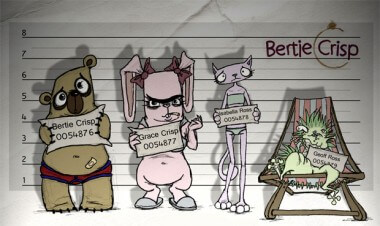
©2011 Francesca Adams
Francesca: The hardest voice to cast was for Grace, because I’d heard, oddly enough, one of my nan’s voices in my head, which is kind of similar but more Northern. She had to sound harsh, like she smoked, very demanding, a bit like Waynetta Slob, that sort of thing. When we were researching the film we weren’t really looking at animations at all, we were watching stuff like “Harry Enfield”, “The Royle Family”, “Shameless”. I was hoping for someone like Kathy Burke, and my producer said “Kathy Burke, then?” I didn’t think we’d get her but amazingly we managed to and she was brilliant. For Bertie, I was watching the Vic and Bob series “Catterick” and Mark Benton’s character seemed very Bertie-like. We were struggling to cast for Isabella as she doesn’t have that many lines, we knew we wanted someone with a strength as well as a calmness to her. I did mention Tamsin Greig, being a big “Green Wing” and “Black Books” fan, and again my producer managed to get her. Amazingly we managed to get all our first choices cast, it was brilliant and lovely to work with them, though petrifying at first!
Did the voice acting lead to any changes in the character animation itself?
Francesca: Yes, there were a few bits that did change ‘cause I found Grace a lot more energetic, which wasn’t a bad thing at all, it just added a new side to her. The minute we’d had the voices recorded the characters became so much more real, it was like “They exist!” Then we got Nik Powell to do Geoff as a little extra, we were worried about offending him but he was very excited!
Given the edgier subject matter have their ever been any disproportionate negative reactions, or do people generally get where you’re coming from?
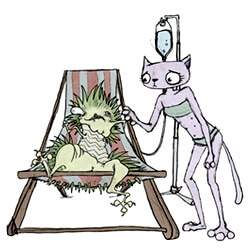
Isabella and Geoff, “Bertie Crisp” (©2011 Francesca Adams)
Francesca: Well, I had been giggling along with things, “Oh, we’ve got this character, he’s a bit mangled” and then all of a sudden I thought “Well…we kind of throw a disabled person off a cliff! Is this going to offend people?” It was only getting toward the final screening that I had come out of the bubble where you’re just panicking about the technical side of things. Honestly, it was just a bit of a laugh and luckily it seems that everyone else takes it as such, as a bit of dark humour.
Without giving too much away, there’s a particularly well-observed moment toward the end that hints at the taboo relief of being unburdened of someone that needs constant care and attention.
Francesca: I was quite worried that this wouldn’t translate, where Isabella sort of does have this moment of this guilty relief. Some people pick up on it, occasionally it’s lost but I’m glad we kept it in. One of the things we were playing with, if we were to ever make a series was to have her actually try and subtlely euthanise Geoff every episode, like she loves him so much but she can’t cope with him. Then there are all these questions of whether he’s actually a bit more ‘with-it’ than you’d think, does he actually know exactly what’s going on? We managed to keep a couple of those moments in the final script.
How important a role did the music play in communicating your story ideas?
Richard: Before we even really had the bones of the idea I’d said “I love film music and I want a film to be driven by music, without any dialogue, all the emotional cues will be done via music”. My composer Jon Wygens told me he was learning to play the banjo, which was perfect. We listened to a lot of old, folksy American music alongside the biggest film scores we could think of. So it builds up to a full orchestra and then we strip it back to that ‘man-learning-to-play-the-banjo’, which kind of sums up the character – he knows what he wants but he’s not the best he’s gonna be yet. When he builds the dam with the animals we get a full American band playing, with jaw harps and flutes and everything, but on his own it’s like, “I kind of know what I’m doing but I get it wrong a bit”, that worked really well.
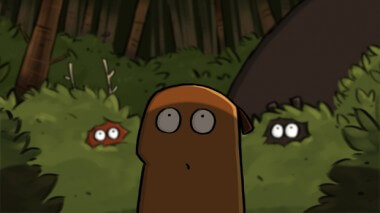
Still from “Damned” (©2011 National Film and Television School)
We had a great time, as much money as we could get we’d spend on musicians, going through lots of ideas, big-American, small-American, we originally tried a theremin for when the billboard rose out of the water, to give it a sort of sci-fi feel, but that made it too ‘b-movie’. It wasn’t really a sci-fi moment, it’s a religious moment, so we ended up using a choir. I really enjoyed it, as well as the sound mix; because the billboard woman isn’t animate, she’s just a poster, whenever she rocks she makes a sound, so we looked into whatever weird metal sounds we could find. We scraped a piece of air duct along an old tin bathtub, the ‘oooh’ sound we got from that we figured that would be her ‘voice’. Just by pure chance our sound recordist, Howard, was in North America filming a documentary near a forest, so I made him go into the woods and record things! So this poor guy stood in the middle of nowhere with his mic, going “Is this enough forest atmos?” – “Find some beavers!”
Francesca: With ours we wanted a theme tune, because the idea is for it to double as a pilot and we wanted music that would hopefully stay in people’s heads. Again my editor was very good at choosing the temp tracks, which were always genius, I felt that Gideon and I were very much on the same level. The temp track we used got in everyone’s head, we’d hear people whistling it in the corridors. I wanted something people would hum and whistle to too, which was quite a job for my composer, but she managed to pull it off. The music we’ve got is quite memorable and hopefully very “Bertie” with just the right domestic feel to it.
Sort of bright and yet depressing at the same time.
Francesca: Yeah! That was one thing we wanted to go for, quite nice, calm, almost what you find on seventies adverts where they’re advertising kitchenware. Having that type of music playing while we have this kitten going mental, throwing up everywhere was the exact juxtaposition I wanted, I think we got that quite well. When it came to sound effects I didn’t want anything too cartooney, Mostly I wanted to keep it quite grounded in reality, I quite like the idea of these wacky looking characters but didn’t want the sound to make you go “Eh, a cartoon”. What we do have of that actually comes from the music.
How involved are the NFTS in the distribution and exposure of your work once it’s finished?
Richard: The film school covers a standard set itself of the major festivals first, to try and get big premieres, and it’s up to us to do the rest. We graduated in March and had to hold fire until the first premiere, which in my case was in Edinburgh in June. So since then I’ve been sending it round with a massive spreadsheet, making sure that everything’s ticked and crossed.
Do you find that it’s worth the investment to pay submission fees for some of the higher-end festivals?
Richard: Well, at the moment I haven’t done anything like that. I thought last year, because I’d just graduated and had no money, that I would focus on European festivals with arts council and media funding. The plan is to save up some money and then start aiming for all the American festivals in 2012.
Since graduating and having your films out there the last few months, what kinds of opportunities do you feel have been available to you?
Richard: When we had the grad screening in London at the BFI David Sproxton was there, and that meeting led to me now working as a story artist at Aardman. I’ve also been in talks with an agent in America about taking ideas to Nickelodeon, working on pitches over the phone. Mainly I’ve been freelancing, I’ve done storyboards at Nexus for Tropicana and worked at Partizan on a big Müller ad, which was great fun. We had loads of animators on it, people who’d worked on “Iron Giant” and Disney movies like “The Lion King” and “Aladdin”. It was like “This is the most amazing room I’ll ever see!” Because they’d tell anecdotes, like everyone does about their work, except theirs would go “Remember that time with Brad Bird…?” I didn’t want to leave! So yeah, lots of opportunities since the NFTS, it really has opened doors.
Francesca: I’ve been hoping to see if we could get a few more “Bertie”s rolling but we haven’t had any luck yet. I think I’ll always keep playing with the character but ideally with the same crew back together. My CG guy quite shockingly said he’d be up for some more, after all I’d put him through! So that was a good sign. Until then I’m basically freelancing, animation as well as some storyboard work for Blue Zoo, which I really enjoyed. At the moment I’m working for the BBC, I’ve doing the animated credits for one of their Charles Dickens dramas, so that’s quite far away from “Bertie Crisp”.
Having graduated and started your respective careers what’s your take on the overall landscape and the way things are? Do you have any advice for the next batch of graduates?
Richard: I suppose always in the back of my mind, since before I went to NFTS, was that I’d have to go where the work is rather than have the work come to me, so right now I’m willing to travel. There’s some good work being done in central Europe, there’s the States if you can manage to get in, but I think there are great films being made all over, it’s not just a case of seeing Britain as Britain, I have to be prepared to move around. The guys I worked with on the Müller ads, as well as the Disney guys there were others who’d just finished work in Poland and Hungary. One of our tutors, Barry Purves, his advice was “make sure you’ve all got passports”.
Francesca: Yeah, he says the main two things you need to be an animator are passion and a passport, so we always keep our passports on us because we’ll move where the work is. Because the animation industry feels very close-knit, it’s also hard to break in. Even a year out in the world, having had a couple jobs done, I still feel like I’m trying to find that way in at the moment.
Richard: And yes, it is really hard, but it would be really hard anyway. Just by surrounding yourself with people who are driven and whose work you like, it almost forces you to keep going. You can see how people are improving, it’s like a community. There’s a guy whose work I really love called Tim McCourt who I worked with recently, we’d been following each other’s blogs for years but had never met, it was like “Oh wait, you’re you! I love your work!” So now it’s just great to know him, he’s one of those proactive people, he works with a guy called Wesley Louis who’s an amazing illustrator and animator. Seeing how they do it and keep themselves going, you can’t be despondent or pessimistic. Another tutor we had at the NFTS, Ginger Gibbons, he describes it as a wave; Now we’re on a low but that was the case back when he started out as an animator as well – eventually it’ll come back up again.
“Damned” has been screened internationally since its premiere at the Edinburgh International Film Festival and is presently nominated for an MPSE Golden Reel Award for sound editing. Forthcoming screenings include the Glasgow Youth Film Festival, Animated Exeter and it is presently touring with the London International Animation Festival.
“Bertie Crisp”, similarly touring the festival circuit worldwide, recently won the Audience Choice award at the FLIP International Animation Festival and has also been included as part of the LIAF programme. Both films are in the running for this year’s British Animation Awards, with “Damned” up for Best Student Film and “Bertie Crisp” in Public Choice (you can also watch and vote for Francesca Adams’s BAA Sting entry here).


